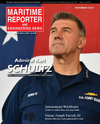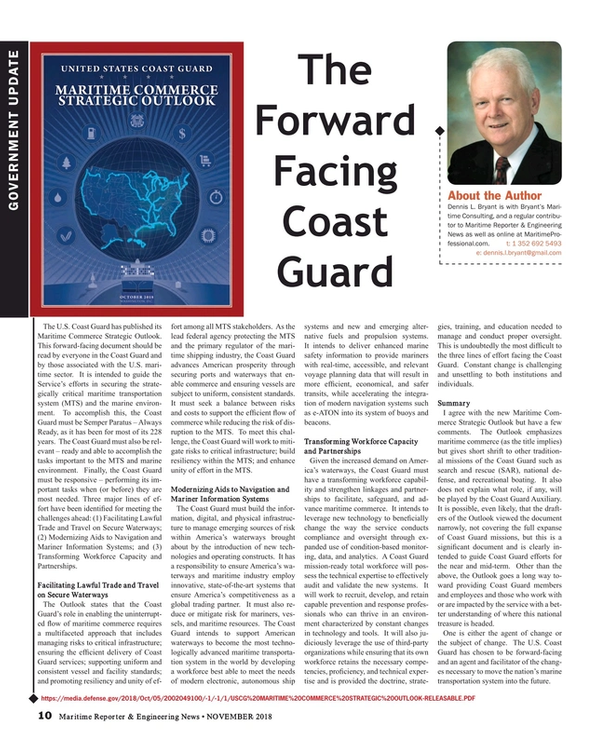
The Forward-Facing Coast Guard
The US Coast Guard has published its Maritime Commerce Strategic Outlook. This forward-facing document should be read by everyone in the Coast Guard and by those associated with the US maritime sector. It is intended to guide the Service’s efforts in securing the strategically critical maritime transportation system (MTS) and the marine environment. To accomplish this, the Coast Guard must be Semper Paratus – Always Ready, as it has been for most of its 228 years. The Coast Guard must also be relevant – ready and able to accomplish the tasks important to the MTS and marine environment. Finally, the Coast Guard must be responsive – performing its important tasks when (or before) they are most needed.
Three major lines of effort have been identified for meeting the challenges ahead: (1) Facilitating Lawful Trade and Travel on Secure Waterways; (2) Modernizing Aids to Navigation and Mariner Information Systems; and (3) Transforming Workforce Capacity and Partnerships.
Facilitating Lawful Trade and Travel on Secure Waterways
The Outlook states that the Coast Guard’s role in enabling the uninterrupted flow of maritime commerce requires a multifaceted approach that includes managing risks to critical infrastructure; ensuring the efficient delivery of Coast Guard services; supporting uniform and consistent vessel and facility standards; and promoting resiliency and unity of effort among all MTS stakeholders. As the lead federal agency protecting the MTS and the primary regulator of the maritime shipping industry, the Coast Guard advances American prosperity through securing ports and waterways that enable commerce and ensuring vessels are subject to uniform, consistent standards. It must seek a balance between risks and costs to support the efficient flow of commerce while reducing the risk of disruption to the MTS. To meet this challenge, the Coast Guard will work to mitigate risks to critical infrastructure; build resiliency within the MTS; and enhance unity of effort in the MTS.
Modernizing Aids to Navigation and Mariner Information Systems
The Coast Guard must build the information, digital, and physical infrastructure to manage emerging sources of risk within America’s waterways brought about by the introduction of new technologies and operating constructs. It has a responsibility to ensure America’s waterways and maritime industry employ innovative, state-of-the-art systems that ensure America’s competitiveness as a global trading partner. It must also reduce or mitigate risk for mariners, vessels, and maritime resources. The Coast Guard intends to support American waterways to become the most technologically advanced maritime transportation system in the world by developing a workforce best able to meet the needs of modern electronic, autonomous ship systems and new and emerging alternative fuels and propulsion systems. It intends to deliver enhanced marine safety information to provide mariners with real-time, accessible, and relevant voyage planning data that will result in more efficient, economical, and safer transits, while accelerating the integration of modern navigation systems such as e-ATON into its system of buoys and beacons.
Transforming Workforce Capacity and Partnerships
Given the increased demand on America’s waterways, the Coast Guard must have a transforming workforce capability and strengthen linkages and partnerships to facilitate, safeguard, and advance maritime commerce. It intends to leverage new technology to beneficially change the way the service conducts compliance and oversight through expanded use of condition-based monitoring, data, and analytics. A Coast Guard mission-ready total workforce will possess the technical expertise to effectively audit and validate the new systems. It will work to recruit, develop, and retain capable prevention and response professionals who can thrive in an environment characterized by constant changes in technology and tools. It will also judiciously leverage the use of third-party organizations while ensuring that its own workforce retains the necessary competencies, proficiency, and technical expertise and is provided the doctrine, strategies, training, and education needed to manage and conduct proper oversight. This is undoubtedly the most difficult to the three lines of effort facing the Coast Guard. Constant change is challenging and unsettling to both institutions and individuals.
Summary
I agree with the new Maritime Commerce Strategic Outlook but have a few comments. The Outlook emphasizes maritime commerce (as the title implies) but gives short shrift to other traditional missions of the Coast Guard such as search and rescue (SAR), national defense, and recreational boating. It also does not explain what role, if any, will be played by the Coast Guard Auxiliary. It is possible, even likely, that the drafters of the Outlook viewed the document narrowly, not covering the full expanse of Coast Guard missions, but this is a significant document and is clearly intended to guide Coast Guard efforts for the near and mid-term. Other than the above, the Outlook goes a long way toward providing Coast Guard members and employees and those who work with or are impacted by the service with a better understanding of where this national treasure is headed.
One is either the agent of change or the subject of change. The US Coast Guard has chosen to be forward-facing and an agent and facilitator of the changes necessary to move the nation’s marine transportation system into the future.
Read The Forward-Facing Coast Guard in Pdf, Flash or Html5 edition of November 2018 Maritime Reporter
Other stories from November 2018 issue
Content
- The Forward-Facing Coast Guard page: 10
- U.S. Flag Vessel Safety page: 12
- Preventing Maritime Vessel Explosions – The Role of the Marine Chemist page: 16
- Software Solutions: Communicate or Stagnate page: 20
- Joey Farrell: Born to Marine Salvage page: 28
- Work‘bots’: Autonomous Vessels Arrive page: 34
- Shipyards: FMG & its Quest to Build USCG Icebreakers page: 44
- Interview: Admiral Karl Schultz, Commandant, United States Coast Guard page: 46
- Interview: Shuichi Iwanami, Commandant, Japan Coast Guard page: 54
- AET Grows in Brazil page: 60
- Shipyard Report: Abeking & Rasmussen page: 66
- Shipyard Report: Detyens Shipyards page: 70
- Water Backed Welding & Fixing FPSOs page: 74


